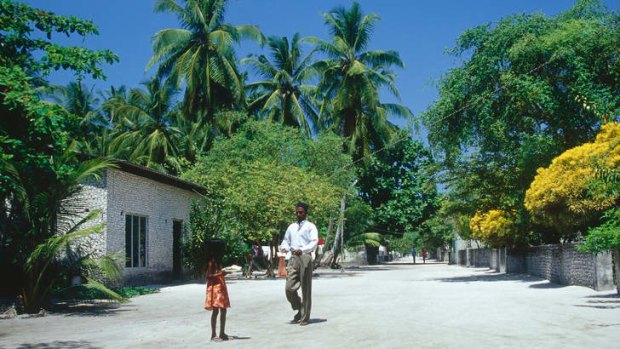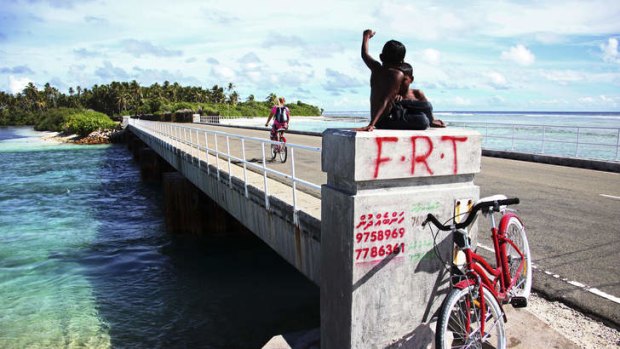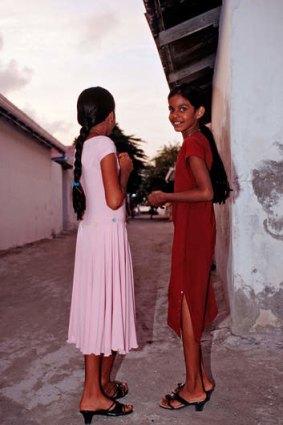
Island insights: life beyond the beaches.Credit: Alamy
Sarfraz Manzoor explores the islands beyond the genteel playgrounds of the rich.
The Maldives: two words that conjure up images of bone-white beaches, luminous blue waters and other-worldly luxury.
I had never visited the islands before, but that was what I was expecting, and my preconceptions were not challenged by the flight from the capital, Male, to Gan airport in Addu Atoll, the southernmost atoll in the Maldives. The plane flew over the shining blue Indian Ocean and tiny green islands that lay in the water like a shattered emerald necklace.

Cycle tours are popular.Credit: Getty Images
I was heading to Shangri-La's Villingili Resort and Spa, which occupies the entire island of Villingili. The island, which is less than 3.2 kilometres long, used to be covered in jungle and there was still some of that wilderness beyond the resort.
Cycling around, I saw giant banyan trees with straggly vines and coconut palms with their trunks bending towards the sea. There were signs pointing me to the spa, tennis courts, restaurants and swimming pool, but I was not there just for all that. Unlike many resorts in the Maldives, the Shangri-La is close to a thriving Maldivian community.
The hotel has begun to offer "cultural tours" that explore the history of the islands and give guests a chance to leave their villas and see how the locals live.

Young Maldivian women.Credit: Alamy
The Shangri-La employs about 300 Maldivians, who live on the neighbouring islands of the atoll and arrive by boat for work.
I saw them on my first morning: traditionally dressed women sweeping the road along which the golf cart, driven by another local, made its way to the Javuu restaurant, where I had breakfast. Another Maldivian man was painstakingly raking the beach.
After breakfast, Imaan, who leads the tours, met me outside my tree-top villa where, just by the front gates, there was a large honeycomb-shaped stone structure.
During World War II the British had an RAF base here - Japan and Germany used the surrounding shipping lanes. This building had been a baking oven. There is also nearby a British garrison building and two gun points located in the grounds of the spa. This is the highest point in the Maldives, but it is only 2.4 metres above sea level, making it the world's lowest national high point.
We cycled to the port, from where a speedboat took us to Gan, the largest island in the atoll. This is where the tourists arrive, and where the super-rich land in their private jets - 10 a month, on average - before entering the cocoon of the Shangri-La. There are still perfectly preserved buildings from the 1930s and '40s on Gan, which is connected to its neighbouring islands by a 17-kilometre road, the longest in the Maldives.
We cycled down the road towards the island of Feydhoo. There were no hotels there and no shops selling tourist tat, because there were no tourists. High-pitched Maldivian pop was playing in someone's living room.
There was graffiti on the walls and the houses were modest and ramshackle, with corrugated iron roofs and water tanks in the gardens, where clothes hung on washing lines.
There were posters of political candidates plastered on the walls, a reminder that the Maldives have been plagued by political unrest since the previous president was forced to resign by an army and police revolt. He was replaced by the brother of the former dictator who ruled the Maldives for 30 years.
Imaan led me inside one house he said was the oldest on the island (it was built more than 150 years ago).
"Where are the owners?" I asked.
"They are out of town," Imaan replied.
"But the door was open," I said.
"We don't lock the doors here," he replied.
It was coming up to noon and the midday sun was fierce. Imaan handed me some local treats to keep me going: boakiba, a spicy mixture of coconut, chilli, tuna and rice, and bajias, which look a little like samosas.
We cycled to the next island of Meedhoo, home to the largest and oldest cemetery in the Maldives. It was built about 900 years ago for the burial of the island's first Muslims, and was a powerful reminder of how the Maldives have been populated for thousands of years, and have their own distinct history and culture.
A British protectorate between 1887 and 1965, the Maldives became an independent republic in 1968. It wasn't until 1972 that the first dedicated tourist resorts were built, but the first settlers are believed to have been Dravidians from south-west India, more than 2000 years ago.
Given their strategic position as a staging-post on trade routes between the Arabian Sea and the Bay of Bengal, the islands became known for cotton goods and coir. Over the years Hinduism, Buddhism and now Islam have all held sway.
It is easy when sitting in the bar of a tourist hotel not to notice the impact of Islam on the Maldives, but following a campaign to boost "Islamic values", public dancing, singing and spas have been banned in the capital and there has been talk that alcohol and mixed-sex beaches could be banned at holiday resorts.
In a children's park I watched a group of girls, aged about six, wearing thick black eyeliner and dressed in bright red traditional clothes, perform a Maldivian dance to music from a mobile phone. It was utterly charming, and performed for me because the children so rarely meet any Westerners.
It was approaching lunchtime; if I had been at the Shangri-La I would have been heading to one of its three restaurants. Instead, today I would be having lunch with Imaan and his family. Imaan is 26, and lives with his brother, four sisters, mother, father and wife. They ushered me to the kitchen.
On the table was a feast: grilled fish, rice, fish soup, chapatis and chicken curry. It was delicious and it felt like a real privilege to have a chance to sample Maldivian home cooking and to see how locals live.
I thanked him and his family and headed back to Gan, where a speedboat took me back to the Shangri-La.
TRIP NOTES
GETTING THERE
Singapore Airlines has a fare to Male for about $1140 low season return from Melbourne and Sydney including taxes. Fly to Singapore (about 8hr) and then Male (4hr 25min); see singaporeair.com.
STAYING THERE
The Shangri-La has a Villingili Escape package from $US720 ($820) a night for two, including meals and domestic flights. See shangri-la.com/male/villingiliresort/.
MORE INFORMATION
Sign up for the Traveller Deals newsletter
Get exclusive travel deals delivered straight to your inbox. Sign up now.